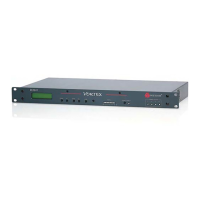This command sets or queries the attenuation level of the Noise Cancellation algorithm on input channels 1-4
and T . For example, if NCL is set to 10, then the Noise Cancellation for that channel will cancel 10 dB of
noise. Higher numbers mean more cancellation will be applied, but may result in slight artifacts depending on
the characteristics of the noise. Typical settings are 10 dB for normal cancellation and 6 dB for light
cancellation.
When the wildcard character, '*', is used to specify the channel in this command, it only affects input
channels 1-4 . To set or query the telephone input channel, T, you must specify it explicitly (e.g.,
'B01NCLT6' '' '', 'B01NCLT?' '' '').
This command is a channel integer command. See
Section 6.3 and Section 6.2 for more information on this
type of command. The minimum and maximum values for this command are 0 and 20, respectively.
This command is saved to non-volatile memory only as part of a preset. The state of this command will be
restored after power-up only if a preset is saved and that preset is set to be the power-on preset.
Example Description Status Message
B01NCL13
Set NC attenuation level on input channel
1 to 3 dB.
B01NCL13
B01NCLT?
Query the NC attenuation level on input
channel 1 .
B01NCLTx , where x is a number between 0
and 20, depending on the current setting of the
NC attenuation level on input channel 1 .
B01NCL*6
Set NC attenuation level on all
microphone input channels (1-4) to 6 dB.
B01NCL*èèèè
B01NCL*ääìì
Set NC attenuation level on input
channels 1-2 to 0 dB and NC attenuation
level on input channels 3-4 to 9 dB.
B01NCL*ääìì
B01NCL*?
Query NC attenuation level on all
microphone input channels (1-4) .
8.115. NVINIT -- Reinitialize Non-Volatile Memory
This command reinitializes (or formats) all non-volatile memory settings. This will effectively erase settings
for global settings, user presets, macros, labels, and logic I/O configurations. This will basically reset the unit
to a "fresh-out-of-the-box" state.
When this command is issued, it writes to non-volatile memory in order to format the contents back to the
factory default state. The writing process results in a short delay. After the non-volatile memory has been
reformatted, the Vortex will perform a software reset, which is equivalent to a power cycle.
Example Description Status Message
B01NVINIT
Reinitialize non-volatile memory and perform a
software reset.
No status message will be generated.
There will be a short delay and then the
Vortex will reset.
8.116. NVLOCK -- Lock/Unlock Non-Volatile Memory

